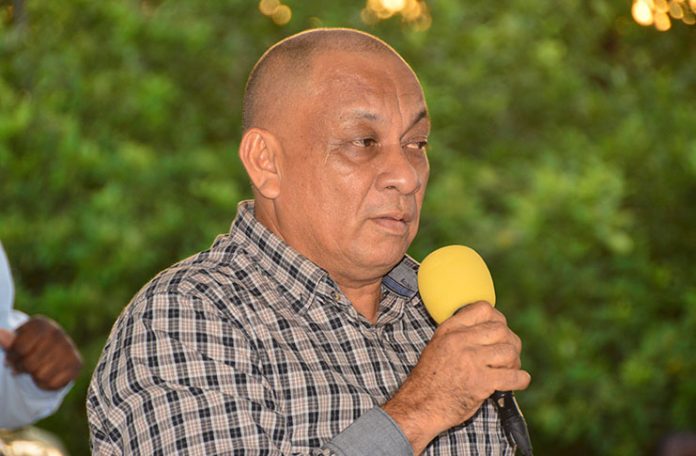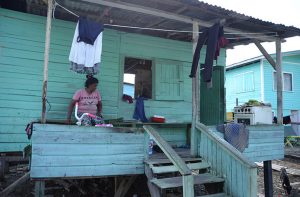Gov’t directs focus on ‘squatting’

…aims to provide better housing options, support livelihoods
INDIRA (only name given) has been squatting at Plastic City, a settlement of the foreshore of the West Coast of Demerara (WCD) for about 27 years. Her home is tiny and dilapidated and is nestled in the settlement of similar structures, and living there becomes difficult- especially when it rains.
Plastic City is referred to as a ‘zero-tolerance’ area, because it is unsuitable for human occupation. The settlement had been established on reserved sea-defense land, where there are mangroves growing in abundance to protect the western coast of the Demerara River. As such, this area is one which cannot be regularised for occupation. “We tried to talk with them individually, it’s just that we didn’t go dismantling their structures. You want to work with people,” Director of the Community Development Department at the Central Housing and Planning Authority (CH&PA), Gladwin Charles related.
Self-settlement, more commonly referred to as squatting, is a situation that has many underlying factors, according to Charles. Persons squat because they cannot afford adequate housing, they squat to continue accessing livelihood opportunities and some even squat for economic gain- where they rent the spaces for small amounts of money. Cognisant of this, he noted that the agency has to be careful how it maneuvers between facilitating “voluntary relocation” or enforcing “forced relocation”.
“I does buy greens and sell at the [Vreed-en-Hoop] market… I been doing that years now,” Indira shared. As a single-parent of nine children, vending has been her main source of income.

For another resident of Plastic City, Koreshma (only name given), she and her husband also work at the Vreed-en-Hoop market. They live in Plastic City with a two-year-old boy and a four-year-old girl, and the woman indicated that if she relocated, she would not have a job.
“In relocation, we also have to look at creating livelihood opportunities,” Charles acknowledged, and explained further: “When they go into the new areas, it’s a new environment… they [have to] readjust and do things that can earn them a living in the new environment.”
And because people want to maintain their livelihoods, Charles indicated that when CH&PA offered alternative housing options, many persons declined. In 2001, the CH&PA recorded 166 structures, of varying sizes, in Plastic City. The body met with the Sea Defence Unit and the area was determined unsuitable for regularisation. As such, the Director noted that persons were advised to apply for house lots.
“In 2004 when we checked, out of the 166 set, only about 60 had applied,” he shared. Over the years, as the government developed La Parfaite Harmonie into a housing scheme, Charles indicated about another 40 persons living in Plastic City were offered lots again. “Only about 20 of them accepted these lots; they said Parfaite Harmonie was too far and they were working at the [West Demerara Regional] hospital and vending at the Vreed-en-Hoop area,” he highlighted.
“It’s not like we say you have to go there. We know it’s a situation where you want to be regularised or relocated but you’re looking for an ideal or close location,” he said.
The self-settlement situation in Plastic City is not an isolated one, however. In the West Demerara region alone, Charles noted that there are small pockets of persons who have self-settled over the years in areas like Crane West, Anna Catherina, Zeelugt and Tushen. In Georgetown, one major area of self-settlement has been Sophia, and in more recent times, Venezuelan migrants were reportedly found squatting at the Non-Pareil foreshore.
To work towards reducing squatting, the Community Development Department has been divided into units; there is now a unit dealing with relocation and one with regularisation.
While speaking to the Guyana Chronicle recently, Charles noted that the department and its units would commence work in Sophia.
“That’s a large area and we have over 500 persons on the reserves or the zero tolerance areas, and they cannot be regularised,” he said.
RELOCATION STUDY
As part of its efforts to provide better housing solutions, CH&PA is currently conducting a “Squatter relocation study”, according to Charles.
“We are working on a relocation plan so that when we’re dealing with relocation it can be more successful in terms of putting all the things in place and getting the stakeholders involved,” he explained. “That study will guide us as to how we could deal with squatters on reserves and on zero tolerance areas.”
This study, according to him, should be finished by mid-year and within the next few months it is expected that the CH&PA would have fact-driven data to guide its interventions.
In Sophia, one resident Mark Wallace indicated that he has been living in Sophia for the past 10 years on a plot of land he called “an island”. According to Wallace, this plot of land is located beyond the ‘B’ Field dam in Sophia, at a ballfield that was subdivided by the previous administration for persons relocated from a reserve.
Wallace said that while squatting is not an ideal situation, relocation has not met him with much more satisfaction.
Aside from Wallace, other residents in Sophia indicated that in some parts there are no basic utilities- running water and electricity, for example. In some cases, these areas might have poor drainage and roads as well.
“In Sophia, the Neighbourhood Democratic Council (NDC) would say that because people are living on the reserves, they can’t clean the drains and sea defence- when you have high tide and rains- they would complain about not being able to maintain the place because of the squatters,” Charles shared. Adding that instances like these call for greater collaboration among the various agencies.
Charles said, “With the unit that we have established, we hope that we can get even more people to understand and work closer with them.”
“Squatting is always a tricky thing, it always needs a collaborative effort,” Chief Sea and River Defence Officer, Kevin Samad shared too. “That’s been a big challenge- that collaborative effort.”
Samad however expressed faith in the collaborative efforts, and noted that sometimes, the most that can be done is to “advise people to desist” and “remain vigilant”. About one decade ago, residents who had been occupying the Lamaha Railway Embankment were forced to relocate. “That was about 260 structures,” Charles explained. “We worked with them; the ministry assisted them with even transportation and we monitored them [in the areas they relocated to].”
While he indicated that the CH&PA, and wider- Ministry of Communities which has oversight for this body, are aware of the varying factors that contribute to the pervasion of self-settlement, the government must work to remedy this.
“One of the things I would tell people, years ago maybe close to 200 persons relocated to Parfaite Harmonie (from the Lamaha Embankment) and at one time they were saying it’s too far,” he said. “But people moved and now we have proper systems in place to monitor these areas, and a lot of persons moved there, and I think they’re happy.”
He posited that though it might be a “sacrifice”, persons were living in better housing spaces which they legally own. And educational and medical facilities, inter alia, were developed in that area.
